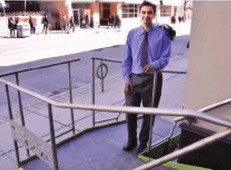Dennis Hanagan–
After almost a year and a half of discussions, a Downtown restaurant owner has his fingers crossed he might have a solution to make his exterior wheelchair ramp acceptable to the city.
 Anjan Manikumar, owner of Signs Restaurant on Yonge St. near Wellesley, put in a ramp leading up three steps to his Yonge entrance in September 2014. The next month he received a city violation notice saying the ramp encroached on city property; it had to be removed.
Anjan Manikumar, owner of Signs Restaurant on Yonge St. near Wellesley, put in a ramp leading up three steps to his Yonge entrance in September 2014. The next month he received a city violation notice saying the ramp encroached on city property; it had to be removed.
But it’s still there.
Manikumar’s restaurant is called Signs because he offers employment to Deaf servers who communicate by hand signing. Along that line of beneficent thought Manikumar wanted to help people in wheelchairs, so he put in the ramp.
“Just because somebody uses a wheelchair we can’t treat them as a second-grade guest and have them come through the back door or come though the kitchen,” Manikumar said in an interview.
“We are fighting for equal access into the building … Plus, with regards to our concept, it is about being all inclusive,” Manikumar said.
The business has hired a lawyer to help with the ramp battle. “It’s not about fighting against the city,” said Manikumar. “The only issue we are fighting for is equal access. We are willing to be compliant with the bylaw as long as it treats everybody fairly.”
The restaurant at 558 Yonge is in what Manikumar describes as a “grandfather” building because of its age. For that reason, he said the city has told him he doesn’t have to make it accessible. “But I want to,” said Manikumar.
The ramp he has can’t be made narrower because it has to be at least the width of a wheelchair. If he used a wheelchair elevator it would take 3 minutes to complete one lift and can break down in winter, Manikumar said.
Although intended to be taken up and put down, his ramp is cumbersome and heavy, so it stays permanently in place. The city has suggested Manikumar find a manufacturer to design a ramp that would be lighter and much easier to deploy, when and as needed.
With that in mind, Manikumar is casting his eye to the United States where he hopes he can find someone to help him. “It’s very hard to find somebody that can design the ramp,” he said.
Luke Anderson of the StopGap Foundation mentioned Manikumar’s ramp problem when he was guest speaker at the February meeting of SEDNA (South East Downtown Neighbourhood Associations).
Anderson has a particular interest in Manikumar’s situation. Once an athlete, Anderson now uses a wheelchair after breaking vertebrae in a mountain bike crash. The foundation he’s with provides businesses with deployable, one-step wheelchair ramps that are permit-free because they’re deemed temporary.
Anderson told SEDNA that Ontario has set 2025 as the year to be barrier-free. “That’s a really big goal. I don’t see us being able to achieve (it). We’re more than half way there in terms of time, but we have so far to go … At the root of all this is our human rights to equal access.”
Manikumar said not only people in wheelchairs use his ramp but also mothers with baby strollers and elderly people on scooters. “They bring the scooter all the way into the restaurant. It serves a great purpose,” said Manikumar.
Visit stopgap.ca to learn more about how businesses can use ramps so people in wheelchairs can access their stores and restaurants.
 TheBulletin.ca Journal of Downtown Toronto
TheBulletin.ca Journal of Downtown Toronto